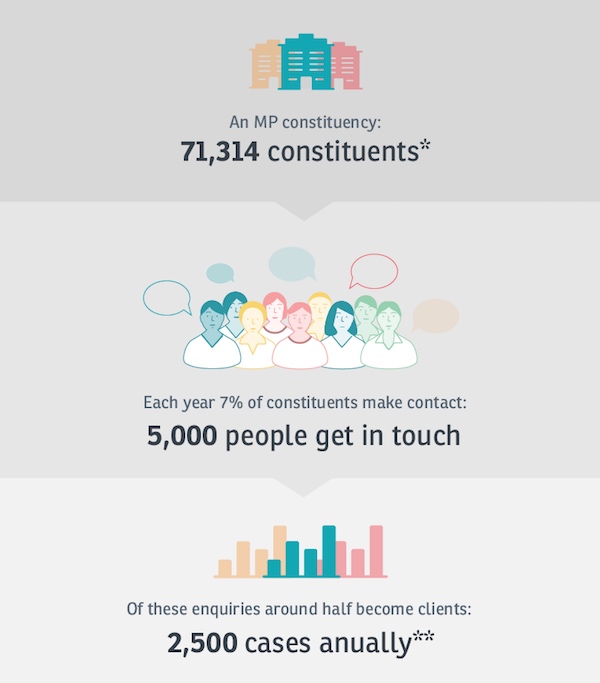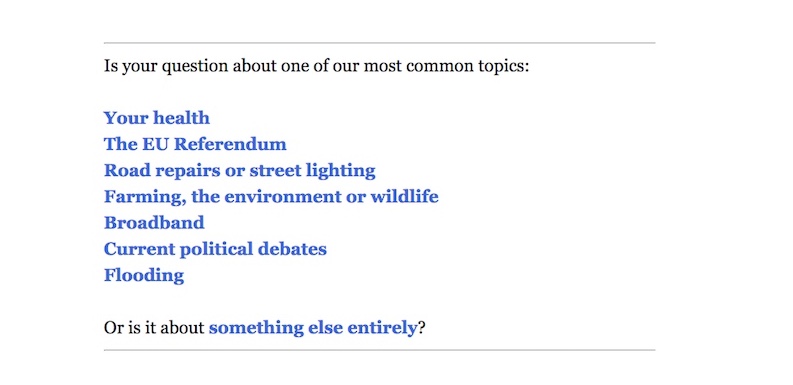Digital technologies can make it easier for constituents to reach their MP and find out about their work, and can help MPs to understand their constituents better.
Public trust in elected representatives is low. We found that many constituents want more information about what their MP does and to know when their MP can help them.
MPs are keen to keep their constituents informed. They want it to be easy for their constituents to reach them and they want to know more about what their constituents think.
There is an opportunity to use digital technologies to help MPs and their constituents understand each other better.What constituents said
MPs do not do well in surveys of trust. In recent opinion polls, only 36% of people (PDF) trusted their local MP to tell the truth, less than a quarter trusted them to represent them in Parliament and three-quarters thought MPs have too much time off.
We interviewed constituents and our MPs shared a survey with their followers to understand more about constituent views of the MP.
We found that constituents wanted to:
- know how their MP can help them,
- be able to contact their MP in a way they feel comfortable with,
- understand their MP's views on different issues, and
- make sure their MP understands local issues so they they are well represented.
What MPs said
An average constituency has over 70,000 residents but only a small number of constituents make contact with their MP. Around half of those getting in touch needed help with a specific problem.

Our MPs told us they wanted to:
Research findings Read more about our surveys and research- increase their reach and make sure they are offering help to a broad range of constituents,
- be able to show their constituents how they are representing them,
- keep constituents informed about what they are doing on their behalf, and
- get help using technology to understand what constituents think on different issues.
We used what MPs and constituents told us to create a set of user needs to inform our work and focused on keeping constituents informed and able to find the right help, as well as taking constituents’ views into account.
Keeping constituents informed and able to find the right help
MPs' websites
The MP's website acts as a “one-stop shop” for constituents to learn about and reach their MP and was the most common way to find MP contact details among the constituents we surveyed.
It is important that the website is clear, simple and transparent for users. It needs to explain the role of the MP, show how they can help and point constituents in the right direction.
Resource Improving MPs' websitesData and visualisation tools can help constituents understand what MPs do but we found that most MPs’ websites don’t take advantage of this.
We explored different ways of publishing information about what MPs are doing, including sharing data about correspondence and building a Google map of an MP’s activity over a month.

Constituents also want to know where to turn when they need help and what their MP can do for them.
MPs want to help constituents in need and are often reluctant to discourage people from contacting them.
But MPs receive many requests for help which could be better handled by other organisations. This takes up MPs’ staff time processing the requests and creates delays in getting help to constituents.
Resource Prototyping a toolWe wanted to show MPs how their website could signpost constituents to the right source of help, while still giving them the opportunity to contact their MP.
We created a prototype which uses different online forms to share the MP’s views on different issues, point people to a better first point of contact (eg their local authority) or, ultimately, provides the MP’s contact details.


Social media
Resource Using live broadcasts to interact with constituentsSocial media has enormous potential for engaging with a broad range of constituents, but MPs are not making the most of it.
Our 2015 survey suggested 84% of MPs have a Twitter account but only 54% of them had a Facebook presence. We think those without are missing an opportunity.
But it is not enough to create an account - MPs need to use these tools effectively.
Our mentors audited the four MPs’ current use of social media and used analytics to understand what types of content worked well.
Then they ran tutorials for Facebook, Instagram and Twitter and created some top tips posters for MPs’ teams. They also provided guidance on dealing with trolls, which we’ll touch on later.
Facebook statistics clearly showed that politicised posts focusing on other parties’ failings were far less effective than positive messages around local issues.
Personal messages were particularly successful. A posting of a family photo on Facebook by one of the MPs saw a reach of over 12,200 users, 342 likes and 89 comments (compared to typical non-personal posts that reach 1,500 - 2,500 users).
And we showed Norman Lamb MP how to use Periscope for the first time for a live EU Referendum Q&A session. The broadcast had 882 live views and has since had 1,800 views.
Email newsletters
Resource Keeping constituents informed with email newslettersA regular email newsletter can be a great way to keep constituents informed and engage them with an MP’s activities in Parliament and in the constituency.
Our MPs were already using email newsletters to communicate with their constituents but not regularly or effectively, so we provided practical tips to improve them by working on structure, content, personalisation, images, call to action techniques and promotion on social media. Find out more.
Taking constituent views into account
MPs work hard to understand local feeling on the issues that affect their constituents but our digital mentors found social media was an underused method of capturing public opinion.
Although some MPs were already using online polls and surveys, they were not doing so extensively or systematically.
We helped Matt Warman MP set up a Conservative party leadership poll on his Facebook page. This provided useful information about his constituents’ views, generated online debate about the candidates and built interaction between Matt and his Facebook audience.
We also showed our MPs how they could use data from their own social media accounts to gauge opinion, as well as identify key contributors to debates and local campaigning groups they might want to work with.
This kind of data can also provide valuable geographic and demographic information. MPs can use this to help identify locations affected by a particular issue or areas within the constituency which are less digitally engaged.